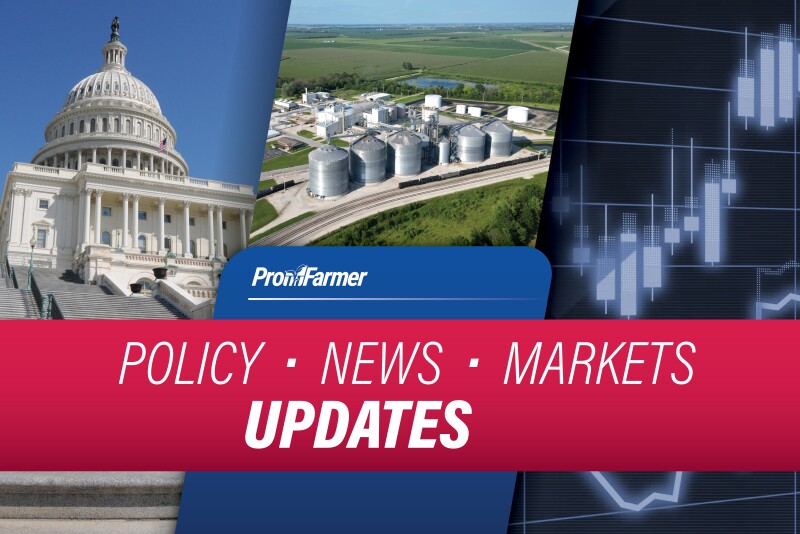Trump delays 50% tariffs on EU as fast-track negotiations begin... President Donald Trump announced on Sunday the U.S. will delay proposed 50% tariffs on goods imported from the European Union until July 9 following a phone call with European Commission President Ursula von der Leyen, who requested more time to reach a trade agreement. Trump had previously threatened to impose the steep tariffs starting June 1.
The EU said it agreed to “fast track negotiations” with the U.S. to avoid a trade war.
Despite the improved tone, serious challenges remain. The Trump administration is pressing for broad concessions from Brussels to reduce a goods trade deficit near $200 billion, including removing EU value-added taxes, food regulations affecting U.S. ag exports and digital services taxes targeting U.S. tech firms.
Many of these fall outside of the EU Commission’s direct authority, further complicating negotiations.
India’s dairy sector pushes back in U.S. trade talks... India’s dairy industry is urging the government to shield it from liberalization pressures in ongoing trade negotiations with the U.S., warning that allowing American dairy imports could devastate millions of small-scale farmers, Reuters reports.
India is in talks with Washington on a comprehensive bilateral trade agreement after the U.S. imposed — and then paused — reciprocal tariffs, including a 26% duty on Indian exports. One key sticking point: the U.S. dairy industry’s push to open India’s heavily protected dairy market, which is currently safeguarded by steep import tariffs and non-tariff barriers.
The Indian Dairy Association and senior trade officials have reaffirmed New Delhi’s firm stance to exclude dairy from the deal, citing both economic and cultural concerns, including U.S. practices involving animal by-products in cattle feed that clash with Indian dietary norms.
Economists warn that lifting protections could flood India with cheaper U.S. cheese, yogurt and skimmed milk powder, undercutting domestic producers and suppressing local milk prices.
Beijing eyes new ‘Made in China 2025’ push amid U.S./China tech rivalry... Beijing is reportedly preparing a revamped version of its landmark “Made in China 2025” strategy to accelerate technological self-sufficiency and secure leadership in critical industries. The plan, potentially branded “Made in China 2035,” emerges amid rising geopolitical tensions and a U.S. policy shift toward “strategic decoupling” under President Donald Trump.
The updated initiative will sharpen its focus on semiconductors and other advanced technologies, especially as U.S. export controls limit China’s access to cutting-edge chips and manufacturing tools. Chinese firms like Naura Technology and AMEC are rapidly expanding their footprint, with domestic suppliers expected to fulfill nearly 40% of global chip equipment demand by 2025.
The original plan aimed to dominate 10 strategic sectors but drew intense criticism abroad, particularly from Washington. While China fell short of achieving 70% chip self-sufficiency by 2025, state support — via tax breaks, procurement policies, and investment funds — significantly advanced local capabilities and market share.
The next-phase strategy is expected to:
- Deepen investments in chip-making and AI applications
- Expand China’s reach in green tech and next-gen IT
- Rebrand to soften foreign resistance while maintaining core goals
- Mobilize public-private collaboration for innovation
Of note: Beijing views advanced AI — driven by firms like DeepSeek — as a lever to challenge U.S. dominance in key economic technologies.
The Trump administration’s response includes up to 145% tariffs on Chinese tech exports and incentives for reshoring manufacturing. A 90-day tariff pause excludes China, prompting supply chain shifts to Vietnam, India and Mexico.
‘Chips, not shirts’: Trump’s tariff comments offer false hope to Asian textile exporters... Garment manufacturers in China and Vietnam welcomed President Donald Trump’s recent comment that America is “not looking to make sneakers and T-shirts,” but industry leaders remain deeply cautious. After enduring years of volatile U.S. tariff swings, exporters have little faith that Washington’s tone will remain steady, according to an article in the South China Morning Post.
Despite a temporary 90-day pause on tariffs — lowering U.S. duties on Vietnamese goods from 46% to 10%, and Chinese goods from 145% to 30% — exporters fear a rapid reversal if no deal is reached by early July.
Vietnam, where garments make up a $44 billion industry, has offered tariff concessions and cracked down on Chinese goods routed through its ports. Still, exporters are hedging by diversifying away from the U.S. market.
Even as Vietnam courts U.S. goodwill — expediting a $1.5 billion Trump golf project and seeing a 40% surge in FDI — exporters know words are cheap.

